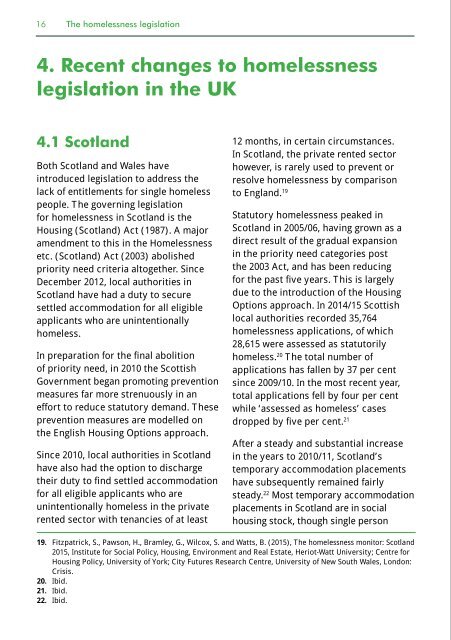The homelessness legislation
The%20homelessness%20legislation,%20an%20independent%20review%20of%20the%20legal%20duties%20owed%20to%20homeless%20people
The%20homelessness%20legislation,%20an%20independent%20review%20of%20the%20legal%20duties%20owed%20to%20homeless%20people
You also want an ePaper? Increase the reach of your titles
YUMPU automatically turns print PDFs into web optimized ePapers that Google loves.
16 <strong>The</strong> <strong>homelessness</strong> <strong>legislation</strong> 17<br />
4. Recent changes to <strong>homelessness</strong><br />
<strong>legislation</strong> in the UK<br />
4.1 Scotland<br />
Both Scotland and Wales have<br />
introduced <strong>legislation</strong> to address the<br />
lack of entitlements for single homeless<br />
people. <strong>The</strong> governing <strong>legislation</strong><br />
for <strong>homelessness</strong> in Scotland is the<br />
Housing (Scotland) Act (1987). A major<br />
amendment to this in the Homelessness<br />
etc. (Scotland) Act (2003) abolished<br />
priority need criteria altogether. Since<br />
December 2012, local authorities in<br />
Scotland have had a duty to secure<br />
settled accommodation for all eligible<br />
applicants who are unintentionally<br />
homeless.<br />
In preparation for the final abolition<br />
of priority need, in 2010 the Scottish<br />
Government began promoting prevention<br />
measures far more strenuously in an<br />
effort to reduce statutory demand. <strong>The</strong>se<br />
prevention measures are modelled on<br />
the English Housing Options approach.<br />
Since 2010, local authorities in Scotland<br />
have also had the option to discharge<br />
their duty to find settled accommodation<br />
for all eligible applicants who are<br />
unintentionally homeless in the private<br />
rented sector with tenancies of at least<br />
12 months, in certain circumstances.<br />
In Scotland, the private rented sector<br />
however, is rarely used to prevent or<br />
resolve <strong>homelessness</strong> by comparison<br />
to England. 19<br />
Statutory <strong>homelessness</strong> peaked in<br />
Scotland in 2005/06, having grown as a<br />
direct result of the gradual expansion<br />
in the priority need categories post<br />
the 2003 Act, and has been reducing<br />
for the past five years. This is largely<br />
due to the introduction of the Housing<br />
Options approach. In 2014/15 Scottish<br />
local authorities recorded 35,764<br />
<strong>homelessness</strong> applications, of which<br />
28,615 were assessed as statutorily<br />
homeless. 20 <strong>The</strong> total number of<br />
applications has fallen by 37 per cent<br />
since 2009/10. In the most recent year,<br />
total applications fell by four per cent<br />
while ‘assessed as homeless’ cases<br />
dropped by five per cent. 21<br />
After a steady and substantial increase<br />
in the years to 2010/11, Scotland’s<br />
temporary accommodation placements<br />
have subsequently remained fairly<br />
steady. 22 Most temporary accommodation<br />
placements in Scotland are in social<br />
housing stock, though single person<br />
19. Fitzpatrick, S., Pawson, H., Bramley, G., Wilcox, S. and Watts, B. (2015), <strong>The</strong> <strong>homelessness</strong> monitor: Scotland<br />
2015, Institute for Social Policy, Housing, Environment and Real Estate, Heriot-Watt University; Centre for<br />
Housing Policy, University of York; City Futures Research Centre, University of New South Wales, London:<br />
Crisis.<br />
20. Ibid.<br />
21. Ibid.<br />
22. Ibid.<br />
households are more likely than families<br />
to be housed in non-self-contained<br />
temporary accommodation, such as<br />
hostels and Bed & Breakfast hotels. 23<br />
Local authorities across Scotland have<br />
reported substantially lengthening<br />
periods of time spent in temporary<br />
accommodation. 24 <strong>The</strong> Panel came<br />
to the view that introducing a model<br />
similar to Scotland would, in the context<br />
of the English housing market, place<br />
significant and unrealistic burdens on<br />
permanent social housing and temporary<br />
accommodation stock, particularly in<br />
London and the South East.<br />
4.2 Wales<br />
<strong>The</strong> Housing Act (1996) was the governing<br />
<strong>legislation</strong> for <strong>homelessness</strong> in Wales<br />
until it was superseded by Part 2 of the<br />
Housing (Wales) Act (2014). <strong>The</strong> majority<br />
of the new <strong>homelessness</strong> provisions came<br />
into force on 27 April 2015.<br />
Prior to the introduction of the new<br />
<strong>legislation</strong>, the Welsh Government<br />
commissioned an independent review<br />
which identified two fundamental<br />
weaknesses with the existing<br />
<strong>legislation</strong>. 25 First, that a growing<br />
emphasis on preventative ‘housing<br />
options’ interventions sat uncomfortably<br />
alongside the statutory system, leading<br />
to concerns about both unlawful<br />
‘gatekeeping’ and inconsistency in<br />
practice across Wales. Second, that<br />
very often no ‘meaningful assistance’<br />
was made available to single homeless<br />
people. 26<br />
<strong>The</strong> key change brought in by the<br />
Housing (Wales) Act (2014) was a<br />
stronger preventation and relief duty for<br />
eligible homeless households regardless<br />
of priority need status. <strong>The</strong> new<br />
<strong>legislation</strong> also extended the definition<br />
of threatened with <strong>homelessness</strong> from<br />
28 to 56 days, providing local authorities<br />
with a more realistic window of time<br />
within which to carry out meaningful<br />
prevention work. Crucially, the<br />
<strong>legislation</strong> is specific about the sorts<br />
of steps that local authorities should<br />
take, or at least explicitly consider, to<br />
demonstrate they have helped relieve<br />
23. Fitzpatrick, S., Pawson, H., Bramley, G., Wilcox, S. and Watts, B. (2015), <strong>The</strong> <strong>homelessness</strong> monitor: Scotland<br />
2015, Institute for Social Policy, Housing, Environment and Real Estate, Heriot-Watt University; Centre for<br />
Housing Policy, University of York; City Futures Research Centre, University of New South Wales, London:<br />
Crisis.<br />
24. Ibid.<br />
25. Ibid.<br />
26. Mackie, P., Fitzpatrick, S., Stirling, T., Johnsen, S. & Hoffman, S. (2012), Options for an Improved<br />
Homelessness Legislative Framework in Wales, Cardiff: Welsh Government. http://wales.gov.uk/docs/desh/<br />
publications/120131improvehomelessframeen.pdf


